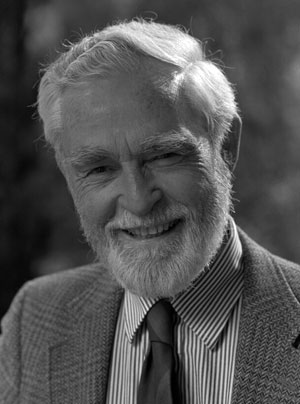The scientific world has lost a true renaissance man (and indeed, one with an interest in Renaissance-era technology) with the death of Ronald Bracewell. The intellect of the Stanford mathematician, physicist and radio engineer ranged across many disciplines, nursing a fascination with etymology, cataloguing varieties of California trees, developing his university’s radio astronomy capabilities and of course, speculating on extraterrestrial civilizations and how they might reach us. The Stanford News Service offers an overview of his rich and crowded life.
Bracewell’s work had wide repercussions, as Umran Inan, professor of electrical engineering at Stanford, recalls:
“Many of Ron’s inventions have flourished in other fields of science and engineering. For example, CAT scans and, basically, the imaging of objects by scanning them through radio and electromagnetic methods are all things that originated with him.”

For those of us focused on space, Bracewell’s work on radiotelescopes stands out. The 32-dish installation he designed at Stanford produced daily solar maps that NASA used during the Apollo program, and he maintained a long-standing fascination with SETI, particularly of the optical variety. Indeed, his modifications to the Fast Fourier Transform improved image processing and signal analysis. But the more speculative among us will always thank him for his concept of the Bracewell Probe, an autonomous device that could carry a civilization’s storehouse of knowledge throughout the galaxy.
Bracewell published over 200 papers and co-wrote the seminal text Radio Astronomy (Oxford University Press, 1955) with J. L. Pawsey. He was also the author of The Galactic Club: Intelligent Life in Outer Space (San Francisco: W. H. Freeman, 1975). A good place to begin in terms of interstellar issues is the key paper “Communications from Superior Galactic Communities,” which ran in Nature 186 (1960), pp. 670-71. The essay is reprinted, among other places, in A. G. Cameron, ed., Interstellar Communication (New York: W. A. Benjamin, 1963), pp. 243-48. Then ponder the Bracewellian nature of Clarke’s monoliths in 2001: A Space Odyssey and consider how deeply his work has affected our view of extraterrestrial contact in the era of ever more capacious computing.
Image credit: Linda Cicero/Stanford University.


Hi Paul
I think Ron was on to something with the idea of sentinel probes – certainly seems more like the exploration approach of a species here for the long-term than a “life-plague” Tiplerian vNM probe. Once we overcome our biology – if biology overcomes us we won’t be here – then why flood the Cosmos with copies of ourselves? I know both Barrow & Tipler have argued the necessity of expanding our physical presence to our cosmic horizon, but to me the Bracewell approach seems more measured, more like a multi-billion year strategy than exponential growth – which Ray Kurzweil speculates ends in a technological apotheosis in a mere 600 years if FTL is viable.
If Kurzweil’s map of our Ascension is correct then we are Alone – no other cosmos-filling intelligence is evident, thus none exists but us (in potentia.) That is unless “God” is such a cosmos-filling intelligence that has Ascended before us, and so on and so forth back to the Beginning. A ‘divine’ line of descent back to the very first technological intelligences that boot-strapped out of the Big Bang.
But if so then what does an Intelligence do with eternity if it has reached ‘god-hood’? Watching how a Universe/Multiverse evolves left to its own out-playing of primordial rules – a “Game of Life” cellular automaton in the Mind of God? Can we rule out the possibility that we’re already in a god scale cellular automaton?
A step down from nerd-theology and the question remains: would post-biological intelligences interfere with the Universe, or observe its evolution? Tipler or Bracewell? Or a cosmic “Cold War” equilibrium with anti-vNMs nipping exponential replicators in the bud? All sorts of wild scenarios can be imagined, but at the end of the day we have only an index of the possible and no hard evidence beyond the simple, qualified non-observation of intelligent activity on a cosmic scale.
His famous book ‘The Fourier transform and its applications” is an important textbook and inspired many. You did not mention it.
The Bracewell reference is to The Fourier Transform and Its Applications (McGraw-Hill, 1965, 2nd ed. 1978, revised 1986). Here’s what the Wikipedia says about Bracewell’s work on Fourier analysis:
“As a consequence of relating images to Fourier analysis, in 1983 he discovered a new factorization of the discrete Fourier transform matrix leading to a fast algorithm for spectral analysis. This method, which has advantages over the fast Fourier algorithm, especially for images, is treated in The Hartley Transform (1986), in U.S. Patent 4,646,256 (1987, now in the public domain), and in over 200 technical papers by various authors that were stimulated by the discovery. Analogue methods of creating a Hartley transform plane first with light and later with microwaves were demonstrated in the laboratory and permitted the determination of electromagnetic phase by the use of square-law detectors. A new elementary signal representation, the Chirplet transform, was discovered (1991) that complements the Gabor elementary signal representations used in dynamic spectral analysis (with the property of meeting the bandwidth-duration minimum associated with the uncertainty principle). This advance opened a new field of adaptive dynamic spectra with wide application in information analysis.”